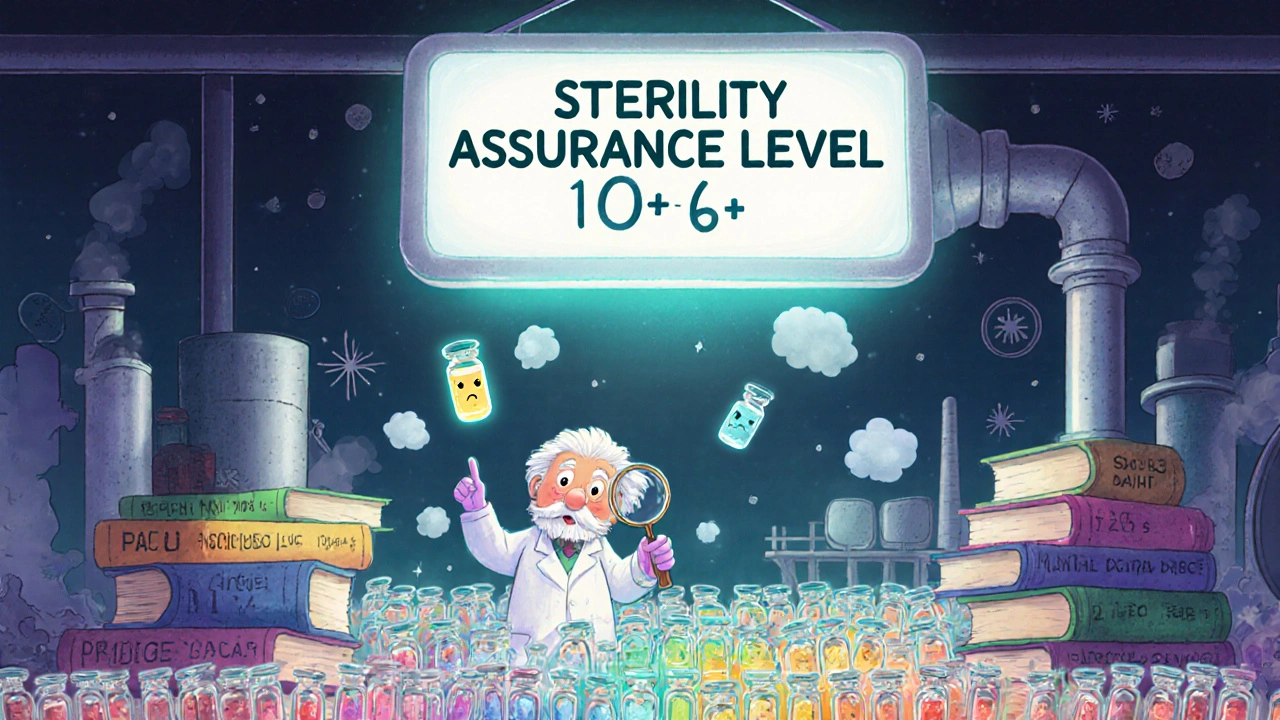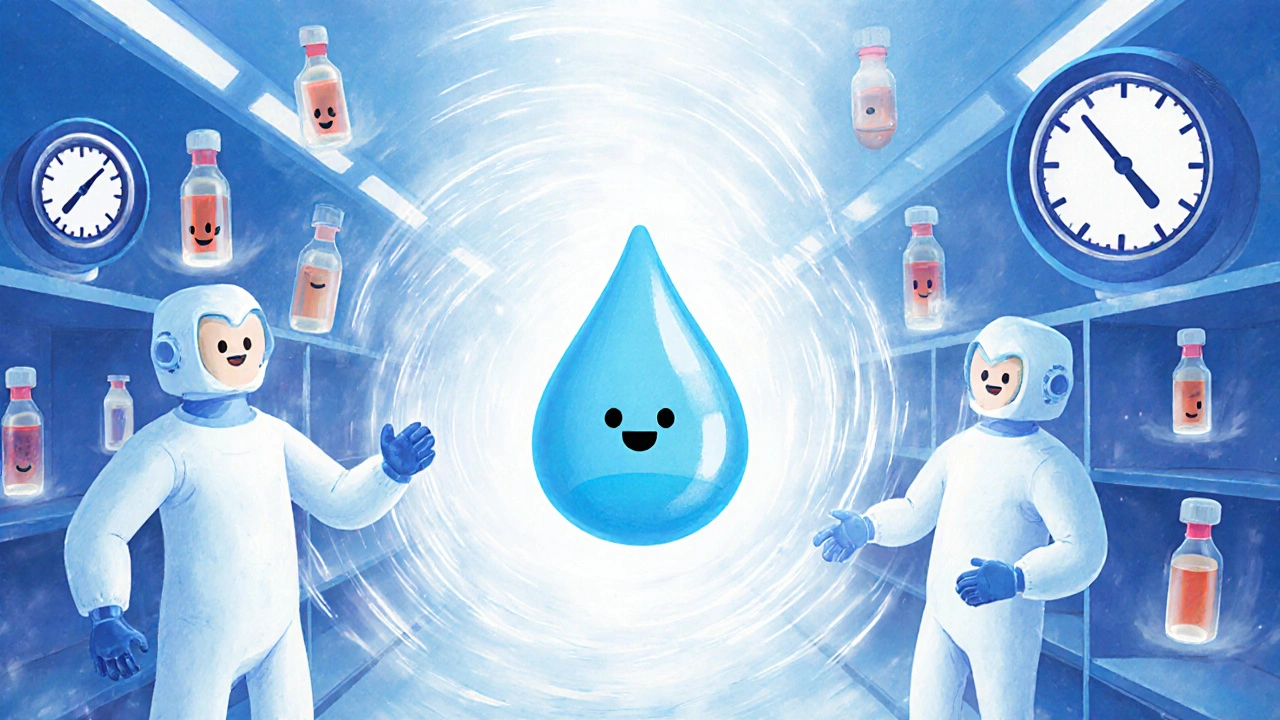When a drug goes directly into your bloodstream - through an IV, injection, or implant - there’s no safety net. Your body can’t filter it. No stomach acid. No liver detox. No immune system waiting at the gate. That’s why sterile manufacturing for injectables isn’t just important - it’s life or death.
One contaminated vial can trigger sepsis. One missed particle can cause a stroke. In 2012, a compounding pharmacy in Massachusetts shipped 17,000 contaminated steroid injections. The result? 751 infections. 64 deaths. The FDA called it one of the worst public health disasters in modern pharmaceutical history. That’s not a hypothetical risk. It’s a documented fact.
Why Sterile Manufacturing Is Different for Injectables
Oral pills? They’re made in clean rooms, sure - but not sterile ones. Dust, mold, bacteria - they get swallowed, broken down, ignored. Injectables? Every single particle, every microbe, every endotoxin must be gone. The standard isn’t "clean enough." It’s sterility assurance level 10-6. That means, statistically, no more than one contaminated unit in a million. No exceptions.
This isn’t new. After the 1955 Cutter Laboratories polio vaccine disaster - where live virus slipped through - regulators forced the industry to change. The FDA’s first GMP rules came in 1963. Today, those rules are stricter than ever. The EU’s Annex 1 update in 2022, the FDA’s 2023 guidance on aseptic processing, and ISO 14644 standards all demand the same thing: zero tolerance for failure.
Two Ways to Get There: Terminal Sterilization vs. Aseptic Processing
There are only two real paths to sterility for injectables. And each has limits.
Terminal sterilization is the simpler method. You fill the vial, seal it, then blast it with steam at 121°C for 15-20 minutes. Or hit it with gamma radiation. This kills everything. It’s reliable. It’s validated. And it’s preferred by the FDA - but only if the drug can survive it. Heat-sensitive biologics like monoclonal antibodies? They’ll denature. Break down. Become useless. That’s why only 30-40% of injectables can use this method.
Aseptic fill-finish is the other option. No heat. No radiation. Instead, everything - the drug, the vials, the stoppers, the machines - is kept sterile from start to finish. This happens in ISO 5 cleanrooms (Class 100). Air moves at 0.3-0.5 meters per second in unidirectional flow. Particles? No more than 3,520 per cubic meter at 0.5 microns. Airborne microbes? Less than 1 colony-forming unit per cubic meter. That’s one microbe in a space the size of a small closet.
But aseptic processing is unforgiving. One glove tear. One cough. One improperly sanitized tool. And you’ve compromised the whole batch. That’s why isolators and RABS (Restricted Access Barrier Systems) are now standard. Isolators are sealed, glove-box-like chambers. RABS are semi-enclosed workstations. Both reduce human contact. Both cut contamination risk by 100 to 1,000 times compared to open cleanrooms.
The Hidden Costs of Sterility
Sterile manufacturing isn’t just hard - it’s expensive. A small-scale facility with 5,000-10,000 liters of annual capacity? Minimum $50 million to build. For a large one? Over $100 million.
Per batch, terminal sterilization costs about $50,000. Aseptic processing? $120,000 to $150,000. Why? More equipment. More monitoring. More training. More testing. More validation.
Media fill simulations - where you run the whole process with growth media instead of drug - must be done every six months. Each simulation uses 5,000 to 10,000 units. If even one vial grows microbes? The whole process fails. And you’ve just lost a $100,000 batch.
One manager at a top 10 pharma company reported three media fill failures in just one quarter in 2023. Each failure cost $450,000. That’s $1.35 million in three months - just from one team’s mistakes.

What You Can’t See Is What Kills You
It’s not just microbes. It’s endotoxins. These are toxic parts of bacteria that survive even after the bugs are dead. They trigger fever, shock, organ failure. The USP <85> standard says water for injection (WFI) must have less than 0.25 EU/mL. That’s 0.25 endotoxin units per milliliter.
How do you get there? Glass vials and stoppers are depyrogenated at 250°C for 30 minutes. That’s not cleaning. That’s incineration. Only then are they safe to touch the drug.
And it’s not just the vials. The raw materials matter too. If a non-sterile excipient has more than 10 CFU/g, it’s a red flag. Even if it’s not sterile, it must be low enough that the final product still meets the 10-6 standard.
Environmental Monitoring: The Real-Time Watchdog
Old-school cleanrooms tested air once a week. That’s gone. Today, EU Annex 1 and FDA guidance require continuous monitoring. Particle counters run 24/7. Air samplers catch microbes in real time.
In an ISO 5 area, you set two thresholds: Alert Level at 1 CFU/m³, Action Level at 5 CFU/m³. Go over 5? The line shuts down. Investigation starts. Batch gets quarantined. You don’t wait for lab results - you act before the results come in.
One facility in Switzerland cut deviations by 45% after installing real-time monitoring. Their batch release time dropped by 30%. That’s not just safety - that’s speed to market.
People Are the Biggest Risk
Even the best isolator won’t save you if the operator doesn’t know how to move, how to gown, how to handle gloves. The FDA found that 22% of sterile manufacturing violations were due to inadequate personnel training.
Staff must complete 40-80 hours of aseptic technique training. Then they must pass a media fill test every six months. No exceptions. No shortcuts. One slip-up in training means a contaminated batch.
And it’s not just the fill operators. Maintenance staff. Cleaners. Engineers. Everyone who enters the cleanroom has to follow the same rules. A single unsanitized tool brought in from the outside? That’s all it takes.

What’s Changing Now - and What’s Next
Regulations are tightening. The FDA’s 2024-2026 plan targets a 25% reduction in sterile manufacturing deficiencies using AI-driven inspections. That means more data, less guesswork.
Automation is rising. Robotic filling systems are projected to grow 40% by 2027. Why? Humans introduce variability. Robots don’t get tired. They don’t cough. They don’t forget to sanitize.
Rapid microbiological methods are replacing 14-day sterility tests. Now you get results in 24 hours. That means faster releases. Fewer batches sitting idle. Less money tied up in inventory.
And digital twins? Companies are building virtual models of their cleanrooms to simulate airflow, contamination risks, and process failures before they ever touch real product. It’s like a flight simulator for sterile manufacturing.
Who’s Doing It Right?
Contract manufacturers - CDMOs like Lonza, Catalent, and Thermo Fisher - now handle 55% of sterile injectable production. Why? Because building and maintaining these facilities is too expensive for most pharma companies to do alone.
But even they struggle. Only 28 of 1,200 Chinese sterile facilities passed FDA inspections in 2022. The gap between regulatory expectations and real-world practice is still huge.
Meanwhile, the market is booming. Sterile injectables hit $225 billion in 2023. Biologics - monoclonal antibodies, gene therapies, cell therapies - are driving 65% of growth. And over 40% of all new drug approvals now require sterile injectable forms.
If you’re not investing in sterile manufacturing, you’re not in the future of medicine.
Final Reality Check
Sterile manufacturing for injectables isn’t about compliance. It’s about survival. For patients. For companies. For the entire healthcare system.
You can’t cut corners. You can’t skip training. You can’t ignore a single particle count. One failure isn’t a bad quarter. It’s a scandal. A lawsuit. A death. And it’s always preventable.
The tools exist. The standards are clear. The cost of failure is known. The only question left is: Are you ready to do it right?

![How to Buy Premarin (Conjugated Estrogens) Online Safely in the UK [2025 Guide]](/uploads/2025/09/thumbnail-how-to-buy-premarin-conjugated-estrogens-online-safely-in-the-uk-2025-guide.webp)




10 Comments
Just read this and had to pause for a minute. The 2012 outbreak still gives me chills. I’ve worked in pharma QA for 12 years, and every time we do a media fill, I think about those 64 families. This isn’t just compliance-it’s sacred work.
Robotic filling is the future. 🤖 No more human coughs, no more glove tears. Just pure, sterile precision. Companies clinging to manual processes are just gambling with lives-and their bottom line.
Man, I never realized how insane the costs are. $150k per batch just to make sure nothing’s floating in there? No wonder generic injectables are so expensive. And don’t even get me started on how often those media fills fail. It’s a miracle anything gets shipped at all.
What’s wild is how much of this is invisible to patients. We trust that the vial is clean, but we have no idea what goes into making it that way. It’s like flying-you don’t see the pilots, but you hope they’re certified. Here, the pilots are wearing full bunny suits and running particle counters at 3 a.m.
Let’s be real-this whole system is a high-stakes game of Jenga. One wrong move, one untrained temp, one broken air filter, and the whole tower collapses. And yet we keep letting people cut corners because ‘it’s just a little dust.’ No. It’s not. It’s a death sentence.
so like... is this all just a scam? like, who even checks if these 'sterile' labs are legit? i bet half of them just fake the logs. i mean, come on. $100 million facility? someone's getting rich off fear.
They’re not trying to save lives. They’re trying to control us. Sterility? More like surveillance. They want you dependent on their sterile vials so you’ll never question the system.
One of the most underappreciated aspects of sterile manufacturing is the training pipeline. It’s not just about SOPs-it’s about culture. People need to internalize that every movement, every breath, every glove change matters. That takes time, repetition, and respect. Not just compliance checklists.
At my last facility, we had a ‘sterility oath’ new hires signed. It wasn’t legally binding, but it changed the vibe. People started correcting each other. Not out of fear-out of pride.
Did you know the FDA doesn’t even inspect every single facility? They pick and choose. And the ones that pass? They’re often the ones with the best PR teams. The real horror stories happen in the places no one ever visits. That’s why I only trust injectables made in Switzerland or Germany. The rest? I’d rather take my chances with pills.
As someone from India, where sterile manufacturing is expanding rapidly, I’ve seen the gap between ambition and execution firsthand. Many labs have the equipment but lack the culture of rigor. Training isn’t a checkbox-it’s a daily practice. We need more mentorship, not just audits. Every technician deserves to be treated like the guardian they are.
The 2022 FDA inspections of Chinese facilities? That wasn’t just a failure of compliance-it was a failure of leadership. You can’t outsource integrity.